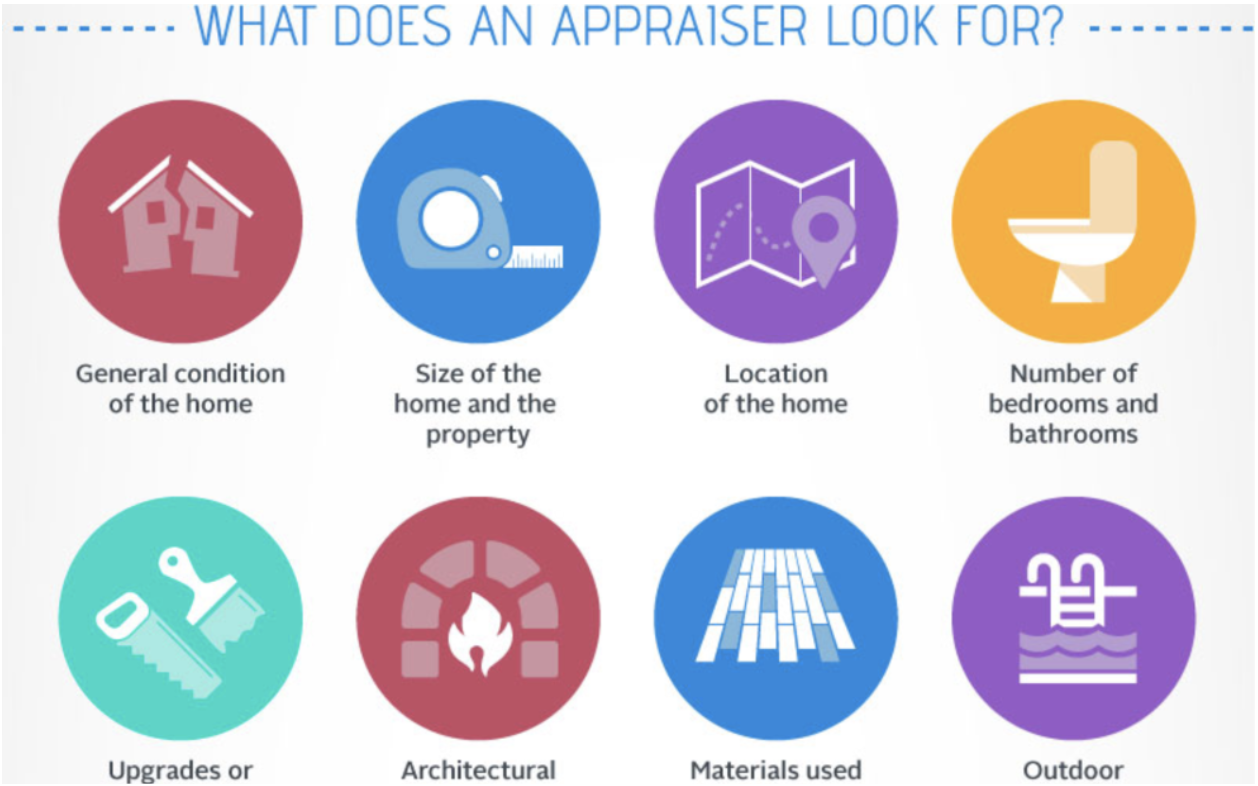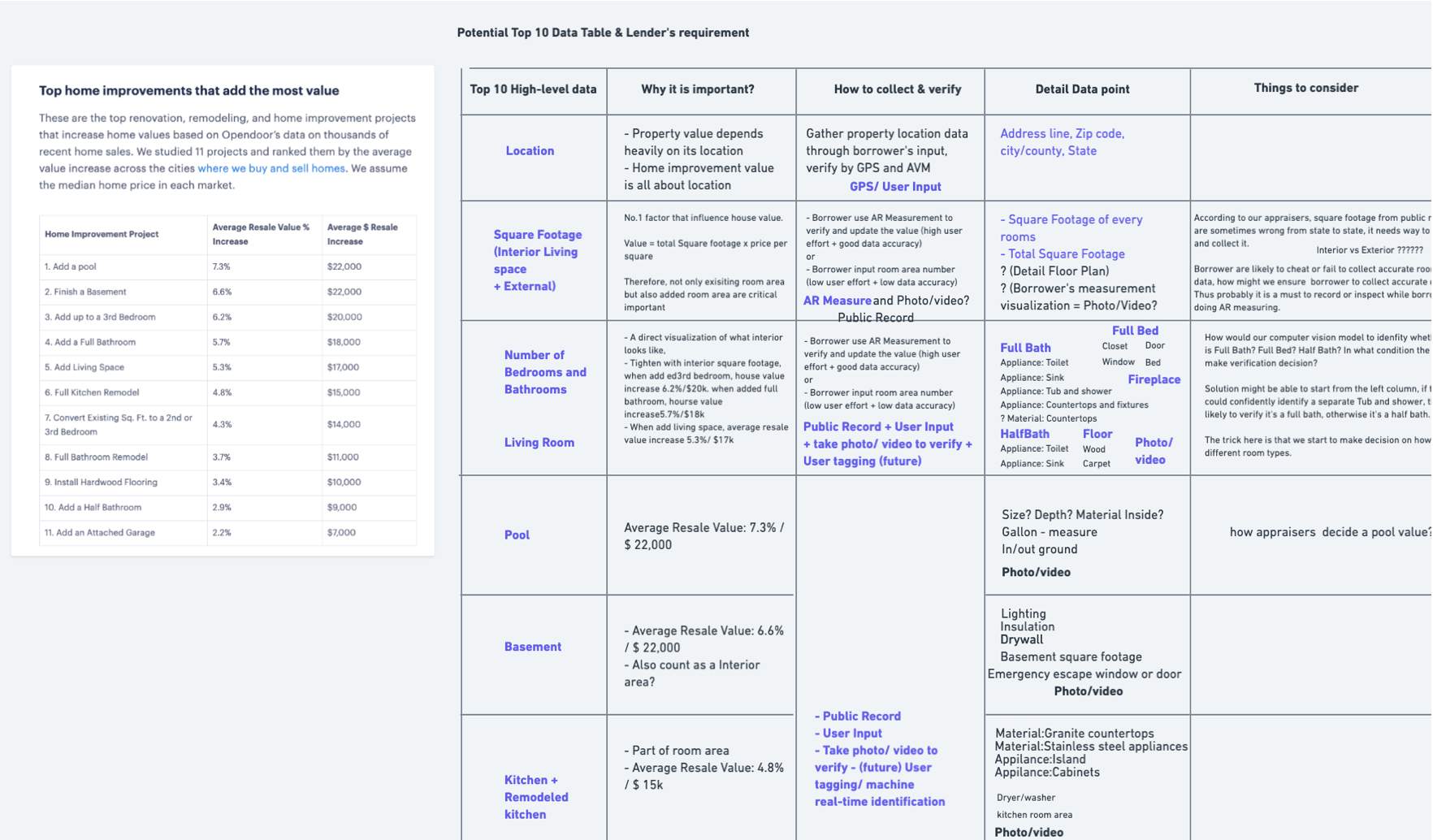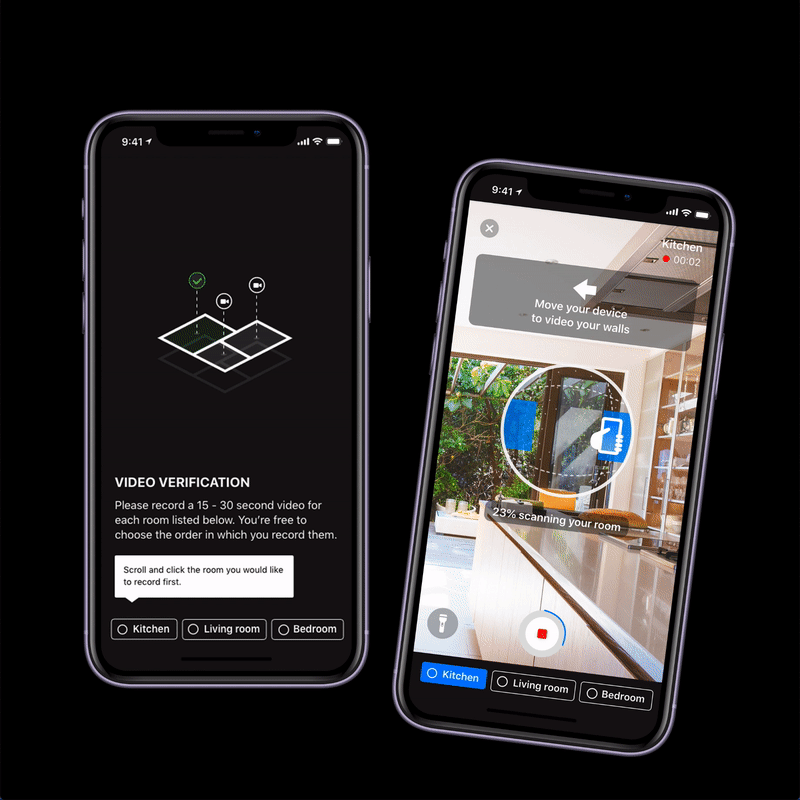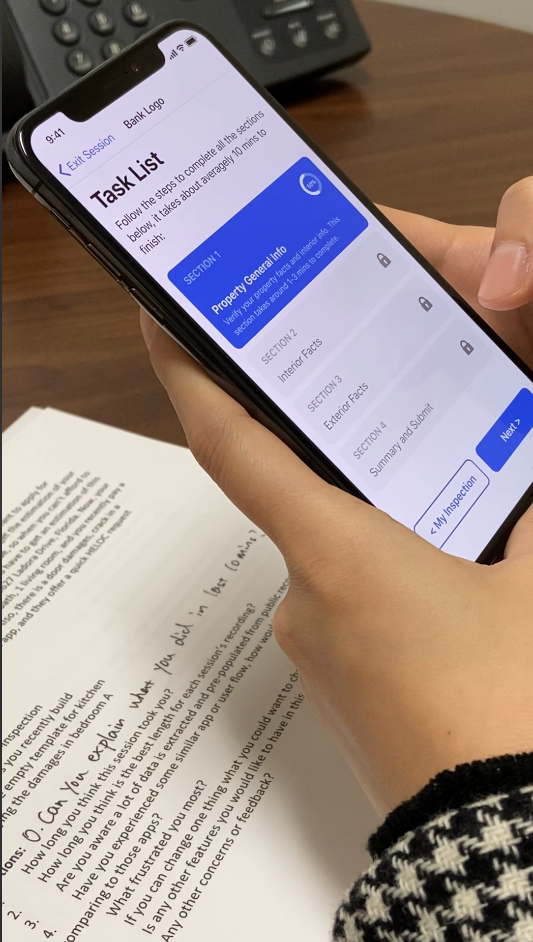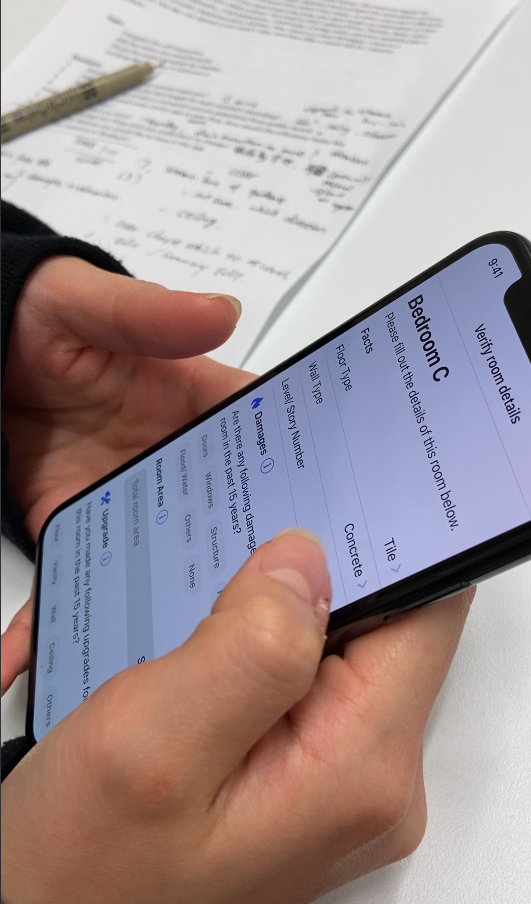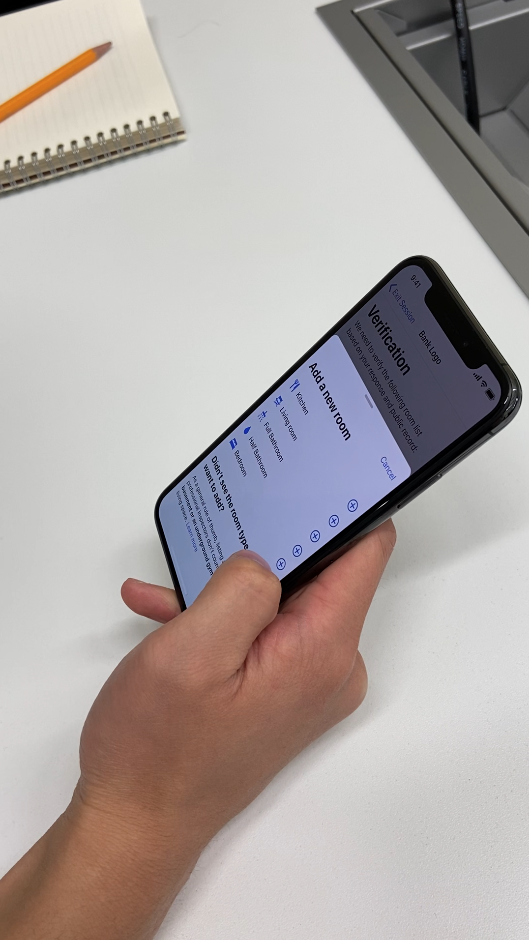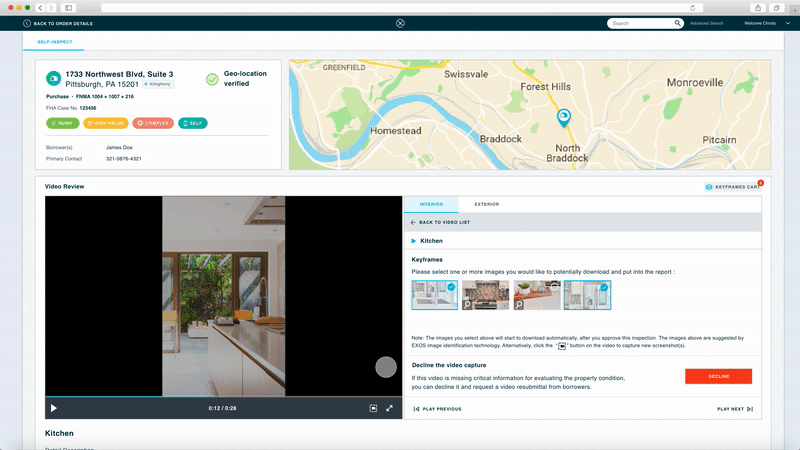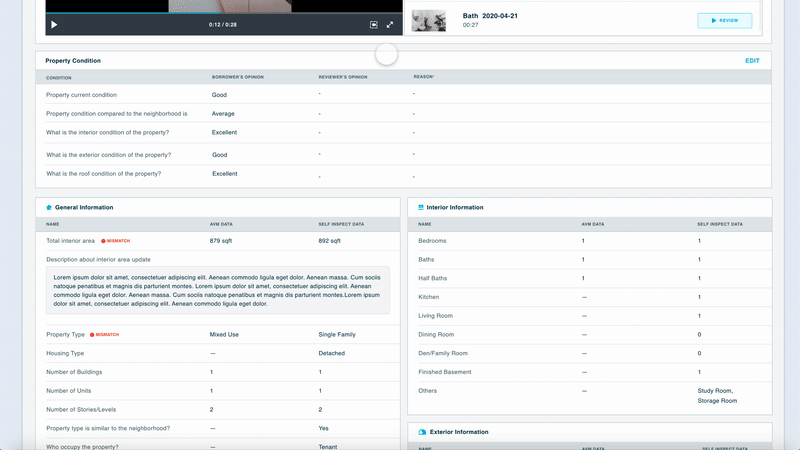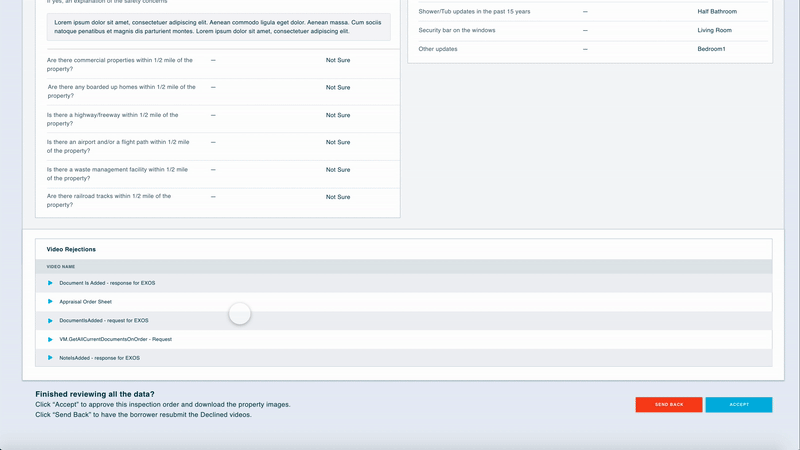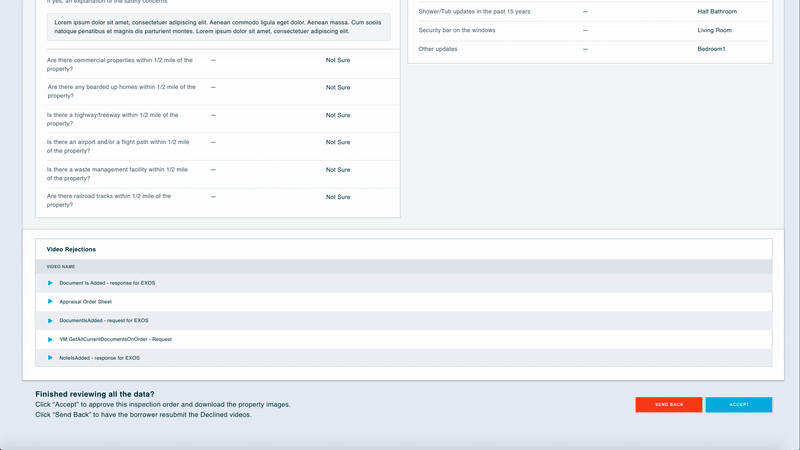Fintech Product Innovation
EXOS Inspect
Transforming Consumer Mortgage Lending and House Appraisal.


Problem
The traditional house valuation process is inefficient and costly, it becomes riskier due to the COVID-19.
Solution
A safe and easy-to-use service that streamlines and eliminates inefficiencies in the appraisal process.
Impact
Finished as fast as less than 20 mins, reduce turn time by 80% and save $60,000 per month, patent pending.
My Role
Lead designer to drive experience Strategy & Vision. I designed up and presented works to gain buy‐in from executives.Context
Transforming Digital Lending and House Appraisal
Mortgage lending and house valuations are closely related.
There are $ 15.2 Trillion in the Home-Equity lending market as of 2018 Q3. And Home inspection software is growing at a rapid rate.
Currently, when a borrower applies for a Home-Equity Loan (HELOC)/ mortgage/ Re-fi, a property appraisal is inevitable and time-consuming.
The borrower needs to schedule a time with a professional appraiser for an onsite house inspection, after-hours inspection, appraiser collected data and spend days/ a few weeks delivering a report to the lender. Consumers will, therefore, wait for the lender’s financial decision for another few weeks.
Within the appraisal process, particularly, the home inspection creates blockers in the process which results in inconvenience for end-user and delays in turnaround times for lenders and appraisers.
And COVID-19 pandemic risk further accelerated the need to streamline and digitalize key touchpoints in the appraisal process.
Problem Statement
The traditional house valuation/inspection process is inefficient and costly, it becomes riskier due to the COVID-19.
Five key issues in the process
#1. Schedule a house appraisal is costly and inevitable
The traditional inspection process requires an appraiser to inspect the house on-site and gather the data, which falls short to engage the customers in this process.
#2. Delayed by scheduling process
The vendor needs to assign an appraiser and they will attempt to reach the contact to schedule a mutually agreed upon time for the inspection appointment, it is not uncommon to see the delay.
#3. Poor customer experience and risky in-person appointment
During the COVID-19, an onsite inspection is raising safety concerns for everyone as it breaks the social-distancing norm.
There is a millionaire who is fearful of the covid, people don’t what stranger into their house, it’s a huge market, an original home inspection is invasive and stressful.
#4. Lending decisions delayed by the poor inspection results
Appraiser/House Inspector can sometimes gather bad data that leading to repeat visits to the borrower’s property.
#5. Data and fraud risk for lenders
Lenders are making decisions based on third-party data or a property report conducted by 3rd party vendors, making an SLA agreement is disturbing.
* * *
Research Discovery
Understanding the Field
Diagraming high-level process
I looked into the current appraisal process in US and mapped a flow digram to accumulate the basic domain knowledge
Review appraisal report
There are comprehensive data that is being gathered, analyzed, synthesized for lenders to make a mortgage decision.
Tools and approaches
By looking into appraiser’s forums, to see their approaches/tools/processes for the property inspection.
Understanding the Home Data
Synthesis
I synthesized the data categories that appraiser care most during inspection.
Data List Analysis
At the same time, we receive an initial Data requirement from a potential client.
Identify data priority
The team iterated on the MVP data list several time for the MVP product.
Insights
“The inspection process is the key for the appraisal, and appraisers have a professional process to gather data.”
“Top data points that will increase house value for the most, but other data matters too”
“Mortgage borrowers nowadays: embracing technology and learning domain knowledge”
“New solutions are out there, however, risk management, security, and fraud prevention has become the major concerns”
Reframing
We know that borrower engagement is the key to the future, but how might we create a new but cost-effective and low-risk service for borrowers and lenders?
Solution Overview
Meet EXOS Inspect®
A live, private label-ready digital platform that streamlines and eliminates inefficiencies in the mortgage process.
With EXOS Inspect, the borrower can now collect home inspection data that the lender needs to make a lending decision - whenever is convenient for the borrower. With EXOS Inspect, it eliminates the need to have an inspector come to people’s homes. The app’s built-in data security features enable users to conduct the home inspection confidently and securely.
The App guide user through every step of the process, ensuring that the borrower provides the necessary information to get the loan funded quickly. It should take just 20 minutes or less for most of the cases.
Providing borrowers with an intuitive and user-friendly process to self-service,
and helping lenders make more informed decisions
From learnings to ideation
Initial Wireframe - A Failed Try
In the design exploration, I realized we should really consider how to really design for borrowers, we want to avoid putting users in a situation that might result in back and forth moving or create unnecessary UI transitions/steps that waste time and increase cognitive load.
Inspired by the identified breakdowns, I’m starting to empathize with the borrowers, and wondering what’s context needs to be considered during the user journey.
Collabrate closely with the product team for the end-to-end workflow
II worked with the business owner, product manager about the workflow, but it seems pretty hard to figure out the lender’s side.
Design Questions
1. How to design a convenient, efficient, and easy-to-use workflow for borrowers?
2. How to create an experience that protects borrower’s privacy?
3. How to design a service that intends to minimize the implementation effort for the lenders?
4. How to develop features that help mitigate data risk as much as possible for the lenders?
App Prototype
Design Highlights
#1. Define an intuitive workflow
“During Inspection, I Don’t want to revisit the places I have been to.“
When considering the easiest user journey, an important product decision I made is that borrower should visit each room to collect all the required data, if there are things that updated or damaged, they should be able to observe in context and capture, there is no need for them to move back and forth. Similarly, it applies to the interior to the exterior journey.
An liner user journey
Design video uploading/processing practices
It like the Youtube video uploading process, the user recorded and uploading a video, they are free to move forward to add video content details, tags, etc and not forced to wait for the processing.
Once they are ready to submit, we'll check if there is a video being processing.
Usability Testing with Think-aloud protocol
With the usability testing results, most of the participants can finish the entire process within 15 mins for a typical US property (2bedroom, 2Bathroom) house. The result help drive the design decision for the video recording user flow.
#2. How to design the experience that protects user’s privacy
Video recording consumer’s house can be privacy-invasive, in this project, I brought about the privacy and legal concerns regarding it.
Concept - Blur out human face and religious symbols
#3. Design a service that intends to minimize the implementation effort
Private-labeled Service and Modularization
Modularize the steps/questions so it’s to configurable by the clients.
Combining EXOS Scheduling with EXOS Inspect to provide alternative options during the mortgage application process.
Visual Design Decision to for White-labeled Service
Business need met with the implementation approach
The majority of client’s App is based on the Native environment, continuing with old implementation norm will comprise the business opportunity, from the product strategy perspective, migrating to Native approach it’s necessary and needed.
Standardized and Modernized native UI components
The standard UI components are considered to have the best choice to work well with client’s App. And due to the tight development schedule, choosing to use native UI components as much as possible and avoid any customization is ideal.
visual design choice
The OS design language are definitely top 3 UI that user familiar with most, the design decision to follow a native visual design style will not only avoid style conflict between EXOS vs Client’s App and therefore save time, but also allows us to support dynamic fonts, assistive technology and dark mode transition easily.
#4. Design to mitigate data risk for lenders
Verification through lender’s data and Geo-fence
First and foremost, where are you?
At the beginning of the entire experience, we need to educate the user that they have been physically at the property address, otherwise, the data is completely invalid.
Geo-fencing validation
We use Geo-fence technology to avoid they’re not inspecting their friend’s property, the accuracy of GPS may be varied based on the OS system, therefore, a product design is made to try to fence an area and verify the user is in that area.
If they don’t, an error state will display to the user to prevent them inspect their friend’s house.
Full Room Capture
Dynamic Instructions
Based on the percentage of each area of the room, a dynamic toast message will be shown on the top of the screen to guide the user to move.
Full Room Capture Progress Visualization
An experimental visualization for full room capture, users movement will control the mobile icon with the circle and paint the circle to provide straightforward feedback. A percentage is calculated of how much the room is being scanned. Our initial threshold is around 80%.
Result validation
User are still be able to submit the video that doesn’t meet our standard, for these scenarios, we break them down based on the calculation metrics and display a confirmation page with an instruction to recapture the video with desired details
Full Room Capture Process
Spec
Data Review, Quality Check, and Video Resubmit Flow
How data review page works?
Play video
#1. Click each room to play video.
Video “Keyframes“ Capture
#2. Users can capture images for later use. Along with the smart suggested images, they can found selected images in the “Keyframes cart.“
Mark as “Decline for recapture“
#3. If the reviewers think the video is missing critical details, they can mark it declined, this means it might be sent back to the borrower to recapture this video.
Property Details (borrower data vs AVM)
#4. Keep scrolling down, reviewers will found room/ property data from Self-Inspect vs AVM.
Approve or decline Self-Inspection
#5. Reviewer double-check the video “declined“ list, if necessary, the reviewer will click “Send back,“ and confirm to send back to borrower to recapture video.
Inform QC team and download keyframes
#6. If accept the self-inspect, it will send to the quality check team. Meanwhile, the borrower will start to download all the “keyframes“ for review to fill out a report.
Borrower Video Resubmit
* * *
Plus - Concept R&D
Room measurement & Floor plan in EXOS Inspect
Concept Prototype
Storyboarding with Smart Glasses
Concept - Onsite Inspect App Concept
Concept - Remote appraisal Concept
Concept - MR Inspection Result Visualization
MR Property Inspection - part 1
It all begins with an idea. Maybe you want to launch a business. Maybe you want to turn a hobby into something more. Or maybe you have a creative project to share with the world. Whatever it is, the way you tell your story online can make all the difference.
MR Property Inspection - part 2
It all begins with an idea. Maybe you want to launch a business. Maybe you want to turn a hobby into something more. Or maybe you have a creative project to share with the world. Whatever it is, the way you tell your story online can make all the difference.
Constraints and Vision
Certainly, it is too early to consider property scanning for appraisal or happens in everyone’s smart glasses.
But AR/VR/MR is in high growth, and 5G is coming, it is obvious that people will embrace these emerging technologies soon.
For this project and its MVP, we are focusing on borrowers, and particularly millennials, as they tend to own a house, and apply for HELOC / home insurance within the next 10 years.
For the future, we hope that everyone is able to conduct inspection using our products, which means not only borrowers could use this app to collect property data, but also videographers/ professional inspectors/junior appraisers could use it to handle their inspection work.
Outcome
Less than 20 Mins
Based on testing, the average process takes 20 minutes or less.
[Source]
Patent Pending
I was selected to be one of the inventors of EXOS Inspect and patent assigned.
[Source]
Reduce appraisal cost by up to 90%
Through business stakeholders and R&D software engineer’s estimation, it will help reduce an appraisal cost by up to 90%. [Internal estimation]
Reduce appraisal cost by up to 80%
Through business stakeholders and R&D software engineer’s estimation, it will help reduce the turn time from 5 days to 1 day. [Internal estimation]
Featured in
“…makes the appraiser’s personal visit redundant, but still provides him or her with necessary information and visuals to complete the appraisal.“
[Source]Mortgage Bank Association Conference 2020 - Tech Demo: EXOS Inspect.
[Source]National Mortgage News, Digital Mortgage Conference Keynote - Enabling Complete Digital Consumer Experiences.
[Source]Featured in multiple housingwire website posts, also mentioned in 2021 HW Tech100 Mortgage Winners, EXOS Technologies.[Source]Reflection
Partner with Developers Early, don’t exclude development partners until a design is ready.
Our developers were core partners in the design process, contributing ideas and validating feasibility along with them. At the end of the day, they were much more invested in building the final product, as it was designed collaboratively.
Be Careful of Design with New Technology, Research thoroughly and Build Use Case First
Innovation should never focus on the technology itself. Emerging technology, as the design material, should also serve for a clear vision and a solid use case that solve a real-world problem.










